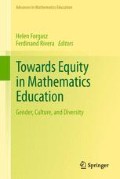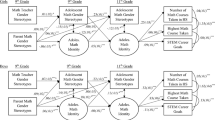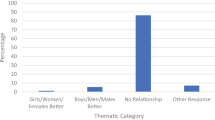Abstract
Evidence reported by Kaiser, Hoffstall and Orschulik suggests that German girls and boys hold stereotypical attitudes regarding gender and mathematics, and that these biases strengthen during adolescence. These results raise important questions about the sources of students’ beliefs, including their view of girls as succeeding in mathematics through diligence and boys as succeeding through ingenuity. Addressing these disparities must involve grappling with differences in boys’ and girls’ classroom behaviors, their self-perceptions in relation to mathematics versus other subjects, and societal beliefs about the nature of mathematics, itself.
Similar content being viewed by others
Keywords
These keywords were added by machine and not by the authors. This process is experimental and the keywords may be updated as the learning algorithm improves.
Gender patterns in mathematics attitudes and beliefs are remarkably consistent across many countries and cultures, as highlighted in recent international assessments. For example, Else-Quest et al. (2010) examined TIMSS and PISA data and found a strong pattern of gender differences in mathematical affect across most countries, with girls reporting less self-confidence and greater mathematics anxiety than boys.
In order to illuminate the nuances and potential origins of these patterns, it is helpful to have more detailed, country-specific studies such as that conducted by Gabriele Kaiser, Maren Hoffstall and Anna Orschulik. In their study conducted in Germany, they administered an adapted version of Leder and Forgasz’ (2002) Who and Mathematics questionnaire to roughly 600 11-to-12 year olds and another 600 15-to-17 year olds. They found strong, stereotypical attitudes among the older students, with younger students reporting far less biased attitudes.
Some of the differences they report are striking. For example, there was a strong tendency by the 15–17 year old students to report that girls need to work harder than boys to do well in mathematics. This pattern was not evident among the 11–12 year olds, raising questions about how exactly this belief emerged during the intervening years. Another disturbing pattern they report is that the tendency amongst girls to claim that mathematics is more important for boys’ rather than girls’ futures increased strongly from the younger girls to the older ones.
Kaiser, Hoffstall and Orschulik also analyzed the reasons students gave for their answers to the question, “Who do you think achieves more in mathematics and why?” When students explained why girls might outperform boys in mathematics, the majority of responses pertained to girls’ diligence, whereas the most popular explanations for boys’ superiority pertained to their mathematical interest and logic, with effort rarely mentioned. These patterns were, again, stronger among older students than younger students. The authors also report that girls rated their own mathematics achievement lower than that of boys, despite the fact that German girls tend to perform at least as well as boys on mathematics achievement tests.
The authors appropriately include the caveat that their sample of German students was essentially a “convenience sample” and not randomly selected. However, schools were chosen from among four different types—low achieving, mid-achieving, high achieving and comprehensive. One potentially fruitful path the authors could explore further is how gender interacts with school type—both in terms of the composition of students (e.g., whether boys and girls are equally represented at each type of school) and whether stereotypical views are more or less prevalent at the different schools. Given that gender-related disparities in mathematics course taking and outcomes are often more pronounced among higher-achieving students (e.g., Forgasz 2006; Lubienski et al. 2004; Robinson and Lubienski 2011), and given that future mathematicians and scientists are most likely to emerge from high achieving schools, it would be worthwhile to compare gender-related patterns in the lower- and higher-achieving schools.
Overall, the study’s results resonate with general findings about gender disparities in attitudes and beliefs from international assessments (e.g., Else-Quest et al. 2010), as well as recent findings from the Early Childhood Longitudinal Study (ECLS), a large-scale, nationally representative dataset in the United States. For example, analyses of the ECLS data have revealed that differences in U.S. girls’ and boys’ perceptions of their mathematical competence are larger than differences in both actual performance and interest in mathematics. Moreover, students’ feelings of competence in mathematics are significant predictors of their later mathematics gains (Lubienski et al. 2011). Additionally, teachers in the ECLS dataset rate girls as better behaved and more diligent than boys (Rathbun et al. 2004; Ready et al. 2005). However, when comparing boys and girls with equal mathematics test scores and similar classroom behavior, teachers rate boys’ mathematics proficiency higher, and this “over-rating” appears to relate to the gender gap in mathematics achievement that emerges in the elementary grades (Robinson et al. in preparation). Taken together, the results from both Germany and the U.S. raise concerns about teachers’ perceptions and treatment of boys and girls in mathematics classes, and the ways in which that differential treatment might impact boys’ and girls’ views about themselves and gender in relation to mathematics.
But what are the root causes of these gender-biased perceptions? The conclusion drawn by Kaiser, Hoffstall and Orschulik is that girls and boys internalize teachers’ and wider society’s faulty stereotypic beliefs about who is good at mathematics. However, this conclusion might be too quick to discount students’ observation skills and might not quite capture the full picture.
Perhaps the students in this study, after years of personal experience in the schools, are not simply reporting stereotypes they have internalized from others but are, in fact, reporting what they have observed day after day in their classrooms. So, for example, the male German student who reported that “boys achieve correct solutions by thinking whereas girls use the right formulas” might, unfortunately, be accurately reporting the tendencies he has noticed among his fellow students. In fact, the boy’s statement is consistent with some prior research, such as one small-scale study of U.S. students’ approaches to mathematical problem solving, in which young girls used more standard algorithms and young boys used more invented strategies (Fennema et al. 1998).
Given persistent evidence that girls are more compliant and diligent than boys in school—evidence collected from girls, boys, and teachers alike—it is likely that girls and boys do, in fact, behave differently in the mathematics classroom. This differential behavior could contribute to many of the patterns reported in this study. However, additional questions arise. Why are girls more likely to exhibit “good girl behavior” in the mathematics classroom, making greater efforts to complete tasks as instructed? In what ways might boys be rewarded for acting independently and girls encouraged to conform? In addition to societal stereotypes about mathematics, should we also be concerned about girls’ feelings of worth being intertwined with their ability to please others—a notion that seems somehow magnified in the mathematics classroom context?
Another troubling question is, “Why do girls report greater anxiety and insecurity when it comes to mathematics performance, even when they outperform boys?” Comparisons between mathematics and literacy are illuminating in this regard. For example, Correll (2001) found that U.S. males view themselves as better in mathematics relative to females with equal test scores, but the opposite was true for reading. This pattern suggests that societal views about mathematics, literacy, and gender influence students’ perceptions of their own abilities.
However, several questions remain. Girls are viewed as more diligent than boys in general, so why does this perception of diligence seem to diminish teachers’ and students’ assessment of girls’ abilities in mathematics, but not in literacy? Is this because mathematics is viewed as something one is either “good at” or not—a measure of fixed, innate intelligence? Hence, are girls’ efforts in mathematics signaling that they are not “naturally” good at mathematics in a way that does not carry over to perceptions of their literacy talents? If so, then rectifying the patterns highlighted by Kaiser, Hoffstall and Orschulik will involve overhauling not only gendered stereotypes about who succeeds in mathematics, but also society’s beliefs about the nature of mathematics, itself.
As mathematics education scholars attempt to push forward on these issues, they must be prepared to answer the “so what?” question that is increasingly asked in relation to work on gender and mathematics. In the case of this study, its importance could be further emphasized if links could be made, for example, between patterns in German student affect and their later career choices. Economic arguments about the field of mathematics losing potentially strong contributors, and women missing out on lucrative career opportunities, can help highlight the continuing importance of gender in relation to mathematics. These arguments are increasingly necessary to make amid claims that it is boys and not girls who are now “shortchanged” in schools (Sommers 2000; Whitmire 2010).
In more immediate, practical terms, Kaiser, Hoffstall and Orschulik rightly conclude that teachers need to be aware of the patterns exposed in this study and should work to build girls’ confidence in mathematics. Still, this admonition likely leaves educators wondering how, exactly, that can occur. Hence, one fruitful line of work would involve identifying the specific aspects that would comprise a successful intervention with teachers and students. What would such an intervention look like? What faulty beliefs about the nature of mathematics, about who can succeed in mathematics, and about the worth of girls, themselves, should be confronted, and how and when is that best accomplished? Perhaps the most important contribution of this study of German girls and boys is that it helps us get one step closer to identifying those beliefs that are most troubling, and pinpointing adolescence as a key period of development of those beliefs among German students.
References
Correll, S. J. (2001). Gender and the career choice process: The role of biased self-assessments. American Journal of Sociology, 101(6), 1691–1730.
Else-Quest, N. M., Hyde, J. S., & Linn, M. C. (2010). Cross-national patterns of gender differences in mathematics: A meta-analysis. Psychological Bulletin, 136(1), 101–127.
Leder, G. C., & Forgasz, H. J. (2002). Two new instruments to probe attitudes about gender and mathematics. ERIC, Resources in Education (RIE). ERIC document number: ED463312.
Fennema, E., Carpenter, T. P., Jacobs, V. R., Franke, M. L., & Levi, L. (1998). A longitudinal study of gender differences in young children’s mathematical thinking. Educational Researcher, 27(5), 6–11.
Forgasz, H. J. (2006). Australian year 12 mathematics enrolments: Patterns and trends—past and present. International Centre of Excellence for Education in Mathematics. Accessed June 12, 2011 at www.amsi.org.au/index.php/component/content/article/78-education/358-forgasz.
Lubienski, S. T., Crane, C. C., & Robinson J. P. (2011). A longitudinal study of gender and mathematics using ECLS data. Final report (grant #R305A080147) submitted to the National Center for Education Research, Institute of Education Sciences, Washington, DC.
Lubienski, S. T., McGraw, R., & Strutchens, M. (2004). NAEP findings regarding gender: Mathematics achievement, student affect, and learning practices. In P. Kloosterman, & F. K. Lester Jr. (Eds.), Results and interpretations of the 1990 through 2000 mathematics assessments of the National Assessment of Educational Progress (pp. 305–336). Reston: National Council of Teachers of Mathematics.
Rathbun, A. H., West, J., & Germino-Hausken, E. (2004). From kindergarten through third grade: Children’s beginning school experiences (NCES 2004-007). Washington: National Center for Education Statistics.
Ready, D. D., LoGerfo, L. F., Lee, V. E., & Burkam, D. T. (2005). Explaining girls’ advantage in kindergarten literacy learning: Do classroom behaviors make a difference? Elementary School Journal, 106(1), 21–38.
Robinson, J. P., & Lubienski, S. T. (2011). The development of gender achievement gaps in mathematics and reading during elementary and middle school: Examining direct cognitive assessments and teacher ratings. American Educational Research Journal, 48(2), 268–302.
Robinson, J. P., Lubienski, S. T., Copur, Y. C., & Ganley, C. M. (in preparation). Gender-biased perceptions of performance affect the early mathematics gender gap.
Sommers, C. H. (2000). The war against boys: How misguided feminism is harming our young men. New York: Touchstone Books.
Whitmire, R. (2010). Why boys fail: Saving our sons from an educational system that’s leaving them behind. New York: AMACOM.
Author information
Authors and Affiliations
Corresponding author
Editor information
Editors and Affiliations
Rights and permissions
Copyright information
© 2012 Springer-Verlag Berlin Heidelberg
About this chapter
Cite this chapter
Lubienski, S.T. (2012). Commentary on the Chapter by Gabriele Kaiser, Maren Hoffstall and Anna B. Orschulik, “Gender Role Stereotypes in the Perception of Mathematics—Results of an Empirical Study with Secondary Students in Germany”. In: Forgasz, H., Rivera, F. (eds) Towards Equity in Mathematics Education. Advances in Mathematics Education. Springer, Berlin, Heidelberg. https://doi.org/10.1007/978-3-642-27702-3_12
Download citation
DOI: https://doi.org/10.1007/978-3-642-27702-3_12
Publisher Name: Springer, Berlin, Heidelberg
Print ISBN: 978-3-642-27701-6
Online ISBN: 978-3-642-27702-3
eBook Packages: Humanities, Social Sciences and LawEducation (R0)




